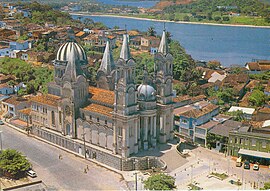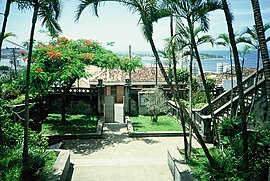Ilhéus
| Ilhéus | ||
|---|---|---|
|
Coordinates: 14 ° 48 ′ S , 39 ° 3 ′ W Ilhéus on the map of Bahia
|
||
|
Location of Ilhéus in the state of Bahia
|
||
| Basic data | ||
| Country |
|
|
| State |
|
|
| City foundation | June 28, 1881 | |
| Residents | 155,281 (2010) | |
| - in the metropolitan area | 184,236 | |
| City insignia | ||
| Detailed data | ||
| surface | 1840.991 km² | |
| height | 52 m | |
| Time zone | UTC −3 | |
| City Presidency | Mário Alexandre de Sousa ( PSD ) (2017-2020) | |
| Website | ||
| Center of Ilhéus with a view of the São Sebastião Cathedral | ||
| View of the park in the upper town of Ilhéus | ||
Ilhéus (old spelling: Ilhéos ; German : Inselchen , small islands ) is a Brazilian municipality and port city with almost 220,000 inhabitants in the state of Bahia at the mouth of the Rio Ilhéus in the South Atlantic. It owes its name to some of the small rock islands off the coast. With a length of 100 km it is the municipality with the longest white sandy beach in Bahia.
Other localities in the municipality are Aritaguá, Banco da Vitória, Castelo Novo, Coutos, Japu, Olivença, Rio do Braço and Sambaituba.
Geographical location
Ilhéus is located 211 km south of Salvador da Bahia and 315 km north of Porto Seguro . The community borders
- to the north at Uraçuca
- in the east to the South Atlantic
- in the south at Una
- to the west at Itajuípe , Itabuna and Buerarema
Ilhéus is located on both banks of the Rio Ilhéus. The two parts of the city are connected by the Ponte do Pontal bridge. Immediately before the bridge, three rivers join to form the Rio Ilhéus:
- Rio da Cachoeira , the mean and maximum, which is about 20 miles away in the Serra Itaraca springs
- Rio Fundão from the north, which is only a few miles long
- Rio Engenho from the south
Further north, the Rio Almada also flows into the Atlantic.
history
King Dom João III of Portugal divided Brazil into captains in 1534. The Portuguese nobleman Jorge de Figueiredo Correia received the area around Ilhéus. In his place he sent Francisco Romero , who founded the Vila de São Jorge on the hill of São Sebastião on the Bay of Ilhéus . In 1881 the place became the city of São Jorge dos Ilhéus , a name that was later shortened.
economy
In the first few years the city lived on sugar cane . Its great heyday came at the beginning of the 20th century with cocoa , which was grown in the hinterland around Itabuna and exported via the port of Ilhéus. This can be clearly read in the early novel Cacau (1933) by Jorge Amado . Ilhéus is the center of the cocoa plantation of southern Bahia and is the seat of CEPLAC, the cocoa institute of Brazil.
As a result of the monoculture , the devastating witch's broom disease occurred, which almost completely wiped out the cocoa trees in southern Bahia between 1989 and 1998. 90% of all cocoa trees in southern Bahia fell victim to this disease caused by the fungus Crinipellis perniciosa . Only in the last few years have more resistant plants (through genetic manipulation) been bred with which a new tree population is built. This is how Brazil, once one of the largest exporters in the world, became an import country for cocoa products. The impact on local agriculture and the ecology of South Bahia is obvious. It led to a real collapse of the local economy and social systems.
Due to the sharp decline in cocoa exports, the seaport of Ilhéus has lost its importance. It was formerly Bahia's main export port for cocoa products.
traffic
Ilhéus has an airport (abbreviation IOS, according to the old spelling Ilhé o s), named after Jorge Amado . The airport is currently served by five airlines: Aviance Brasil , Azul , Gol , TAM and TRIP .
Regular domestic connections
| airline | aims |
|---|---|
| Avianca Brasil | Brasília , Salvador |
| Azul | Belo Horizonte ( Confins ), Campinas , Salvador |
| Gol | Belo Horizonte ( Confins ), Rio de Janeiro ( Galeão ), Salvador , São Paulo ( Congonhas and Guarulhos ) |
| TAM | Rio de Janeiro ( Galeão and Santos Dumont ), Salvador , São Paulo ( Congonhas and Guarulhos ) |
| TRIP | Belo Horizonte ( Confins ), Porto Seguro , Salvador , Vitória |
Until 1989, 65% of the Brazilian cocoa harvest was exported through the port of Ilhéus. But even today it is Brazil's most important export port for cocoa. It opened in 1971. At the time, it was the first port in Brazil to be built in the open sea. The port is also regularly called by cruise ships.
Furthermore, Ilhéus is via various bus connections to various cities, u. a. Salvador and São Paulo attached. There is a connection to nearby Itabuna every 15 minutes.
Culture
Everything is reminiscent of Gabriela , the main character from Jorge Amado's novel Gabriela like cinnamon and cloves , who plays in Ilhéus. Even today you can rediscover some of it in the old center, such as the Palais des "Kakaobarons" Misael Tavares . The house in which Amado lived is now a cultural center named after him.
sons and daughters of the town
- Aldair (* 1965), former Brazilian soccer player
- Esmeralda Barros (1944-2019), actress
- Jorge Amado (1912-2001), writer (grew up here)
Worth seeing
Like many colonial places, Ilhéus has countless churches. The oldest Igreja Matriz de São Jorge dos Ilhéus was built in 1556 . The São Sebastião Cathedral was built in neoclassical style between 1931 and 1967.
In the suburb of Rio do Engenho you will find the third oldest church and the oldest sugar mill (Engenho) of Bahia. The "enchanting lake" (Lagoa Encantada) is 4 km² in size, a nature reserve surrounded by coastal jungle with small waterfalls.
In the south on the road to Canavieiras there are beautiful beaches: Cururupe, Batuba and Olivença.
See also
Web links
- Ilhéus Prefecture website (Portuguese)
swell
- ^ Official census 2010 , ( port. )
- ^ Prefeitura de Ilhéus: Prefeito Municipal. Date: January 1, 2017. Retrieved April 7, 2017 (Portuguese).
-
↑ Google Books:
Journey in Brazil,
on the orders of Sr. Majesty Maximilian Joseph I,
King of Bavaria,
in the years 1817 to 1820






